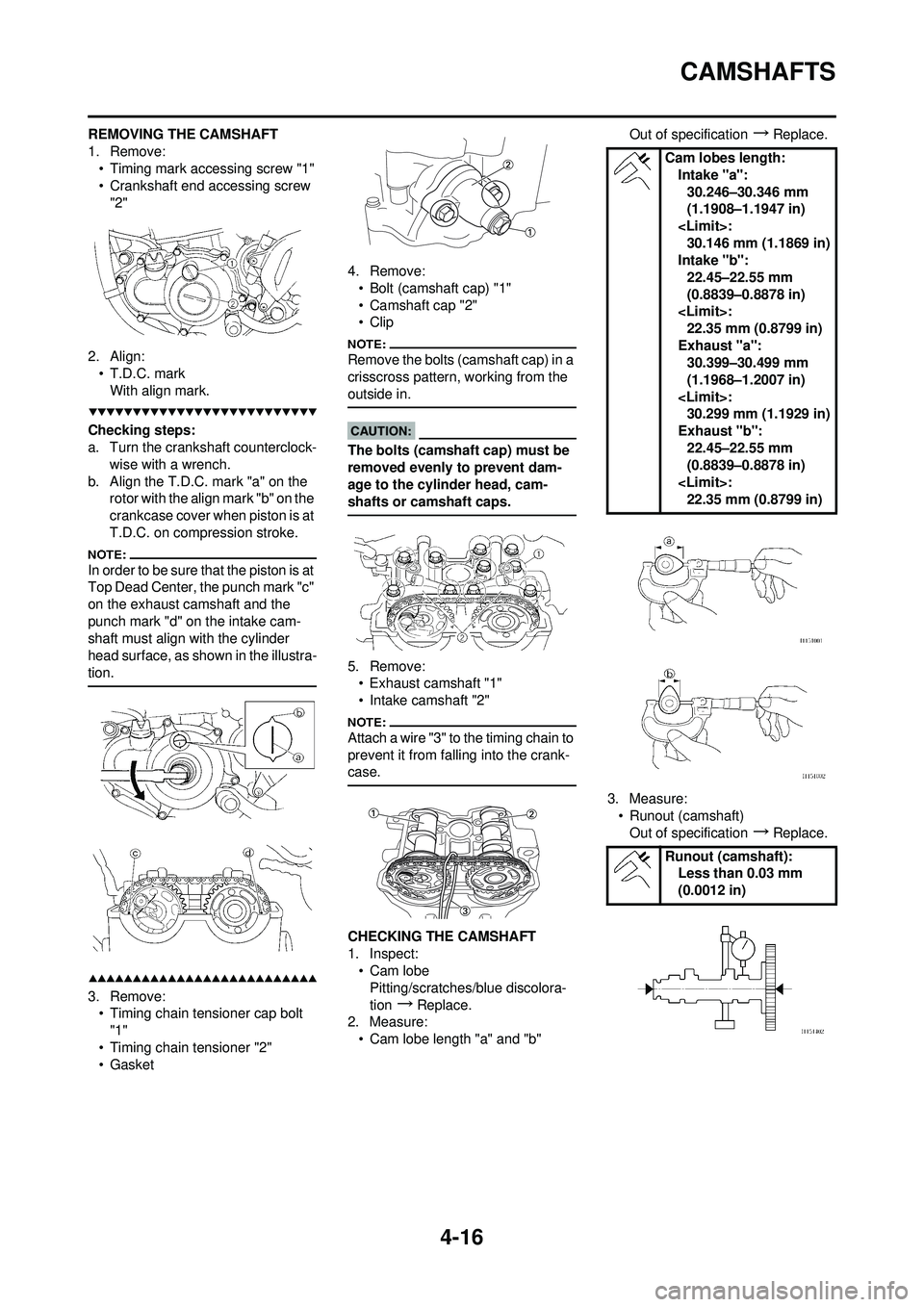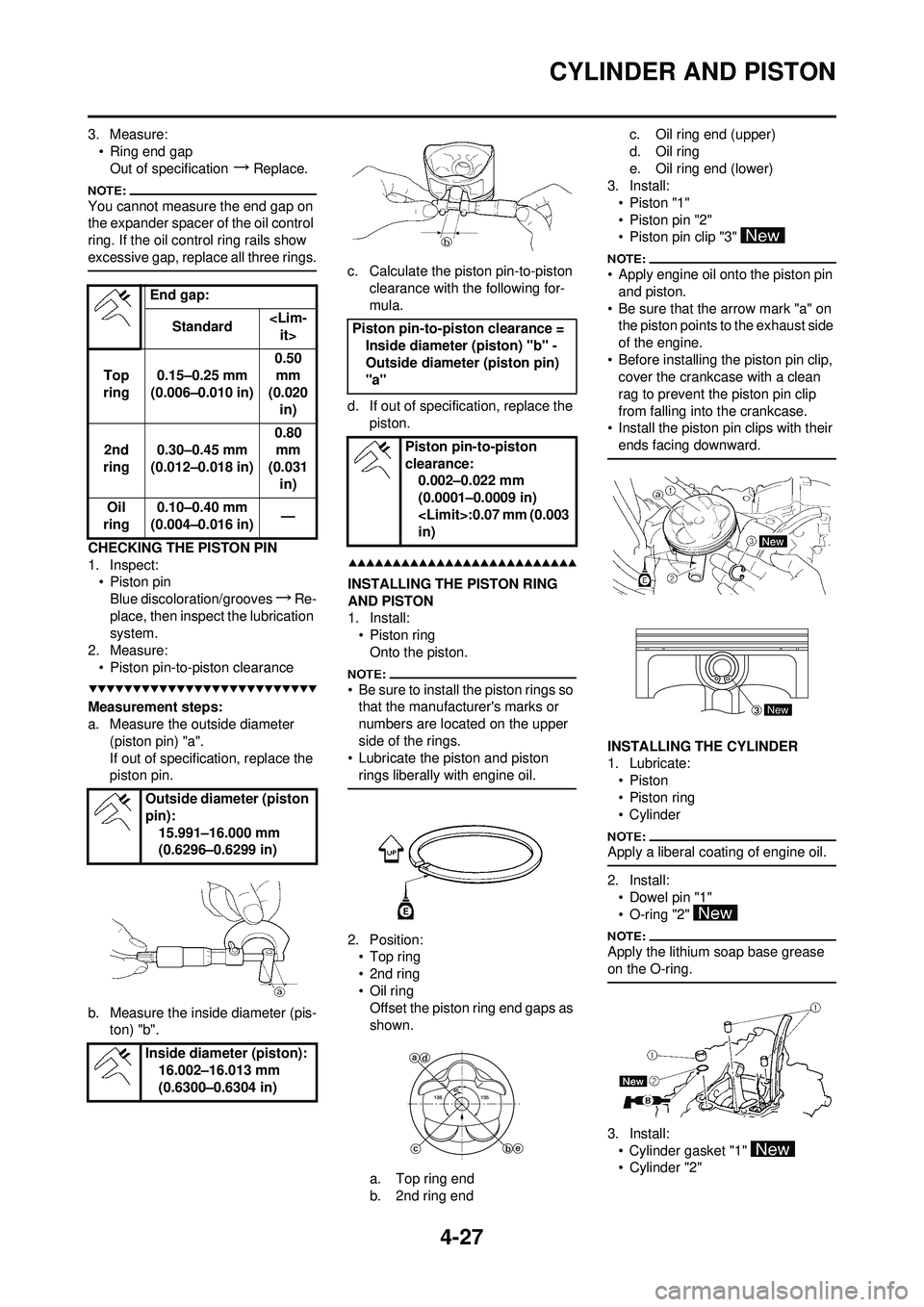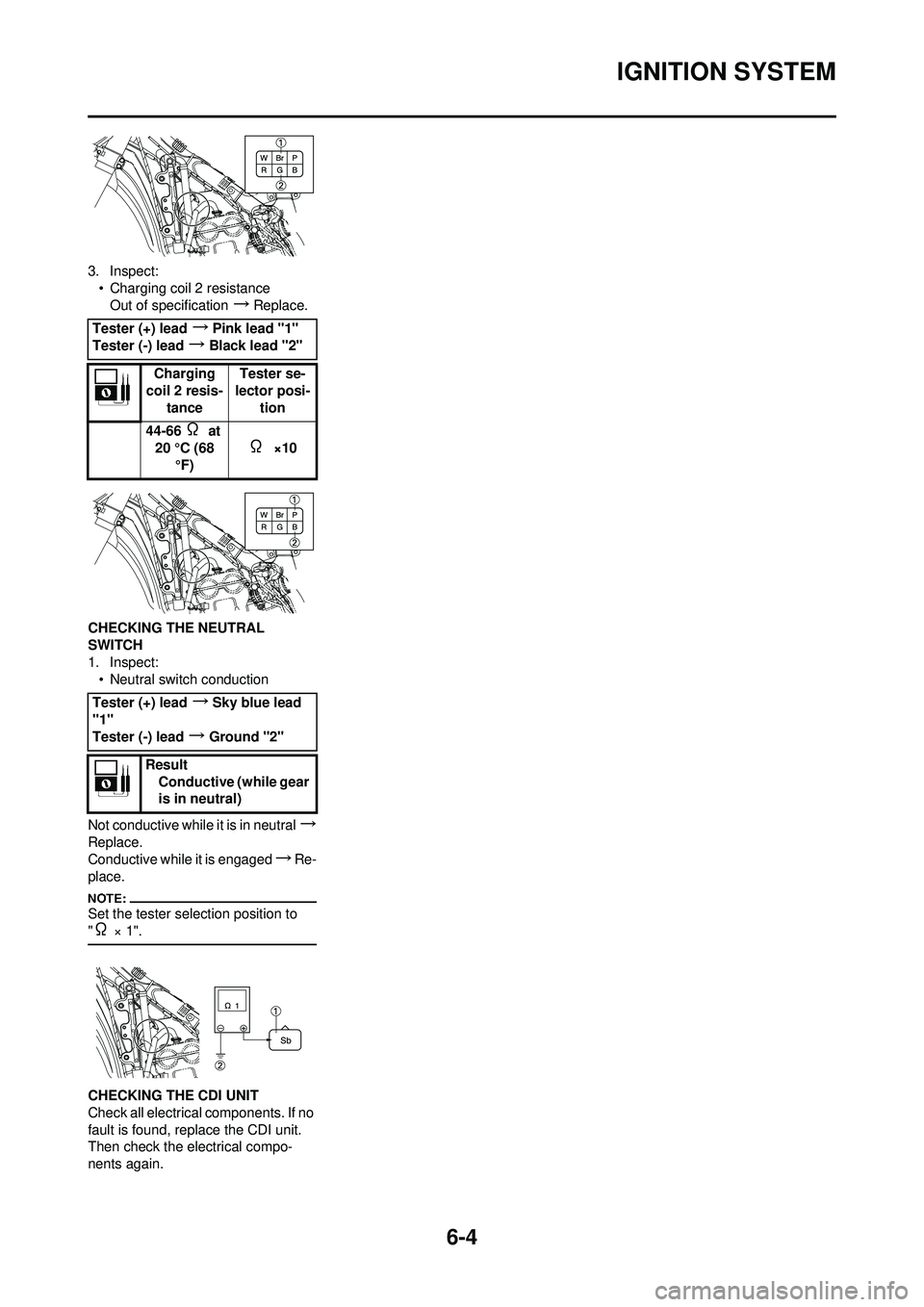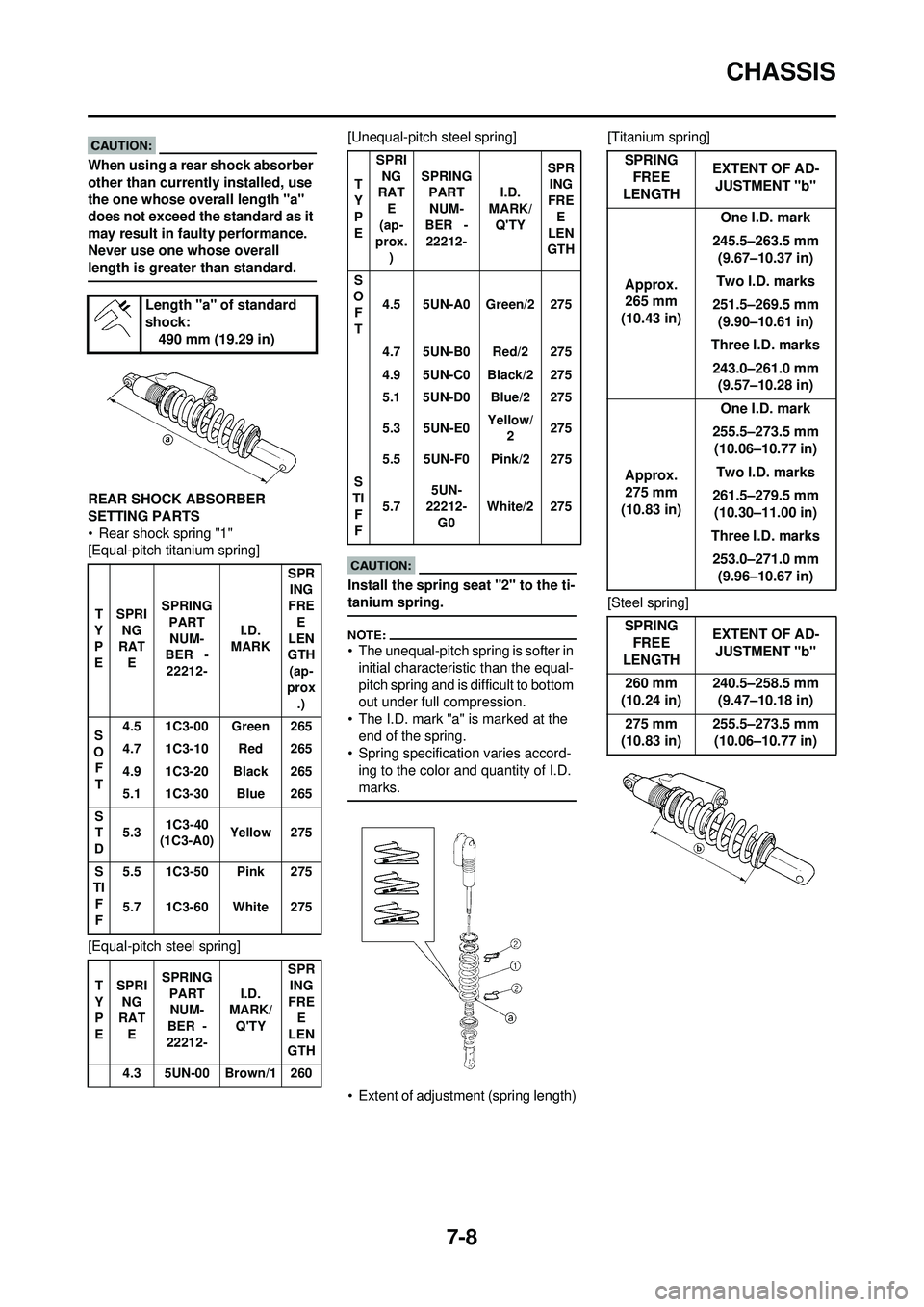ad blue YAMAHA YZ250F 2008 Owners Manual
[x] Cancel search | Manufacturer: YAMAHA, Model Year: 2008, Model line: YZ250F, Model: YAMAHA YZ250F 2008Pages: 192, PDF Size: 7.03 MB
Page 85 of 192

4-16
CAMSHAFTS
REMOVING THE CAMSHAFT
1. Remove:• Timing mark accessing screw "1"
• Crankshaft end accessing screw "2"
2. Align: • T.D.C. mark
With align mark.
Checking steps:
a. Turn the crankshaft counterclock- wise with a wrench.
b. Align the T.D.C. mark "a" on the rotor with the align mark "b" on the
crankcase cover when piston is at
T.D.C. on compression stroke.
In order to be sure that the piston is at
Top Dead Center, the punch mark "c"
on the exhaust camshaft and the
punch mark "d" on the intake cam-
shaft must align with the cylinder
head surface, as shown in the illustra-
tion.
3. Remove:• Timing chain tensioner cap bolt
"1"
• Timing chain tensioner "2"
•Gasket 4. Remove:
• Bolt (camshaft cap) "1"
• Camshaft cap "2"
•Clip
Remove the bolts (camshaft cap) in a
crisscross pattern, working from the
outside in.
The bolts (camshaft cap) must be
removed evenly to prevent dam-
age to the cylinder head, cam-
shafts or camshaft caps.
5. Remove:• Exhaust camshaft "1"
• Intake camshaft "2"
Attach a wire "3" to the timing chain to
prevent it from falling into the crank-
case.
CHECKING THE CAMSHAFT
1. Inspect:• Cam lobe
Pitting/scratches/blue discolora-
tion
→Replace.
2. Measure:
• Cam lobe length "a" and "b" Out of specification
→Replace.
3. Measure: • Runout (camshaft)Out of specification
→Replace.
Cam lobes length: Intake "a":30.246–30.346 mm
(1.1908–1.1947 in)
Intake "b":
22.45–22.55 mm
(0.8839–0.8878 in)
22.35 mm (0.8799 in)
Exhaust "a": 30.399–30.499 mm
(1.1968–1.2007 in)
Exhaust "b": 22.45–22.55 mm
(0.8839–0.8878 in)
Runout (camshaft): Less than 0.03 mm
(0.0012 in)
Page 92 of 192

4-23
VALVES AND VALVE SPRINGS
4. Measure:• Margin thickness "a"Out of specification
→Replace.
5. Measure: • Runout (valve stem)Out of specification
→Replace.
• When installing a new valve always
replace the guide.
• If the valve is removed or replaced
always replace the oil seal.
6. Eliminate:• Carbon deposits(from the valve face and valve
seat)
7. Inspect: •Valve seat
Pitting/wear
→Reface the valve
seat.
8. Measure:
• Valve seat width "a"Out of specification
→Reface the
valve seat.
Measurement steps:
a. Apply Mechanic's blueing dye
(Dykem) "b" to the valve face.
b. Install the valve into the cylinder head.
c. Press the valve through the valve guide and onto the valve seat to
make a clear pattern.
d. Measure the valve seat width. Where the valve seat and valve
face made contact, blueing will
have been removed.
e. If the valve seat is too wide, too
narrow, or the seat is not cen-
tered, the valve seat must be re-
faced.
9. Lap:• Valve face
• Valve seat
After refacing the valve seat or re-
placing the valve and valve guide, the
valve seat and valve face should be
lapped.
Lapping steps:
a. Apply a coarse lapping compound to the valve face.
Do not let the compound enter the
gap between the valve stem and
the guide.
b. Apply molybdenum disulfide oil to the valve stem. c. Install the valve into the cylinder
head.
d. Turn the valve until the valve face and valve seat are evenly pol-
ished, then clean off all of the
compound.
For best lapping results, lightly tap
the valve seat while rotating the valve
back and forth between your hands.
e. Apply a fine lapping compound to the valve face and repeat the
above steps.
After every lapping operation be sure
to clean off all of the compound from
the valve face and valve seat.
f. Apply Mechanic's blueing dye
(Dykem) to the valve face.
g. Install the valve into the cylinder head.
h. Press the valve through the valve guide and onto the valve seat to
make a clear pattern.
i. Measure the valve seat width again. If the valve seat width is out
of specification, reface and relap
the valve seat.
CHECKING THE VALVE SPRINGS
1. Measure:• Valve spring free length "a"Out of specification
→Replace.
Margin thickness:
Intake:
0.8 mm (0.0315 in)
Exhaust: 0.7 mm (0.0276 in)
Runout limit: 0.01 mm (0.0004 in)
Valve seat width: Intake:0.9–1.1 mm (0.0354–
0.0433 in)
(0.0630 in)
Exhaust:
0.9–1.1 mm (0.0354–
0.0433 in)
(0.0630 in)
Free length (valve
spring): Intake:37.81 mm (1.49 in)
(1.45 in)
Exhaust:
37.54 mm (1.48 in)
(1.44 in)
Page 96 of 192

4-27
CYLINDER AND PISTON
3. Measure:• Ring end gapOut of specification
→Replace.
You cannot measure the end gap on
the expander spacer of the oil control
ring. If the oil control ring rails show
excessive gap, replace all three rings.
CHECKING THE PISTON PIN
1. Inspect:•Piston pin
Blue discoloration/grooves
→Re-
place, then inspect the lubrication
system.
2. Measure: • Piston pin-to-piston clearance
Measurement steps:
a. Measure the outside diameter (piston pin) "a".
If out of specification, replace the
piston pin.
b. Measure the inside diameter (pis- ton) "b". c. Calculate the piston pin-to-piston
clearance with the following for-
mula.
d. If out of specification, replace the piston.
INSTALLING THE PISTON RING
AND PISTON
1. Install:• Piston ringOnto the piston.
• Be sure to install the piston rings so that the manufacturer's marks or
numbers are located on the upper
side of the rings.
• Lubricate the piston and piston
rings liberally with engine oil.
2. Position:•Top ring
•2nd ring
• Oil ringOffset the piston ring end gaps as
shown.
a. Top ring end
b. 2nd ring end c. Oil ring end (upper)
d. Oil ring
e. Oil ring end (lower)
3. Install:
•Piston "1"
• Piston pin "2"
• Piston pin clip "3"
• Apply engine oil onto the piston pin and piston.
• Be sure that the arrow mark "a" on the piston points to the exhaust side
of the engine.
• Before installing the piston pin clip, cover the crankcase with a clean
rag to prevent the piston pin clip
from falling into the crankcase.
• Install the piston pin clips with their
ends facing downward.
INSTALLING THE CYLINDER
1. Lubricate:•Piston
• Piston ring
• Cylinder
Apply a liberal coating of engine oil.
2. Install:• Dowel pin "1"
• O-ring "2"
Apply the lithium soap base grease
on the O-ring.
3. Install:• Cylinder gasket "1"
• Cylinder "2"
End gap:
Standard
Top
ring 0.15–0.25 mm
(0.006–0.010 in) 0.50
mm
(0.020 in)
2nd
ring 0.30–0.45 mm
(0.012–0.018 in) 0.80
mm
(0.031 in)
Oil
ring 0.10–0.40 mm
(0.004–0.016 in) —
Outside diameter (piston
pin): 15.991–16.000 mm
(0.6296–0.6299 in)
Inside diameter (piston): 16.002–16.013 mm
(0.6300–0.6304 in)
Piston pin-to-piston clearance = Inside diameter (piston) "b" -
Outside diameter (piston pin)
"a"
Piston pin-to-piston
clearance:0.002–0.022 mm
(0.0001–0.0009 in)
in)
New
Page 174 of 192

6-1
ELECTRICAL COMPONENTS AND WIRING DIAGRAM
ELECTRICAL
ELECTRICAL
COMPONENTS AND
WIRING DIAGRAM
ELECTRICAL COMPONENTS
1. Engine stop switch
2. Throttle position sensor
3. Neutral switch4. CDI magneto
5. Ignition coil
6. Spark plug7. CDI unit
WIRING DIAGRAM
1. Engine stop switch
2. Throttle position sensor
3. Neutral switch
4. CDI magneto
5. Ignition coil
6. Spark plug
7. CDI unit COLOR CODE
BBlack
Br Brown
GGreen
LBlue
OOrange
PPink
RRed
Sb Sky blue
WWhiteYYellow
B/L Black/Blue
B/W Black/White
B/Y Black/Yellow
G/B Green/Black
L/W Blue/White
R/W Red/White
B/WB/W
B/L
B/Y
SbSb
G/B
LYLY
P
B
B
B
B
G
O
WR
P
GW
R
P
B
Br W
W
B/Y G Br
G
RR
OB
Sb Sb
Y
Y
W Y
W
GG B
P P
Br BrRR
O L
B
Sb Y
LL
B/L
B/W
B/W
G/B
B
B
B/L
L
Sb
B/L
G/B
G/B B/Y
B/Y
B/W O
B/W
BrBrP
Page 177 of 192

6-4
IGNITION SYSTEM
3. Inspect:• Charging coil 2 resistanceOut of specification
→Replace.
CHECKING THE NEUTRAL
SWITCH
1. Inspect: • Neutral switch conduction
Not conductive while it is in neutral
→
Replace.
Conductive while it is engaged
→Re-
place.
Set the tester selection position to
"
Ω × 1".
CHECKING THE CDI UNIT
Check all electrical components. If no
fault is found, replace the CDI unit.
Then check the electrical compo-
nents again. Tester (+) lead
→Pink lead "1"
Tester (-) lead
→Black lead "2"
Charging
coil 2 resis- tance Tester se-
lector posi- tion
44-66
Ω at
20 °C (68
°F)
Ω ×10
Tester (+) lead
→Sky blue lead
"1"
Tester (-) lead
→Ground "2"
Result Conductive (while gear
is in neutral)
Page 179 of 192

6-6
THROTTLE POSITION SENSOR SYSTEM
HANDLING NOTE
Do not loosen the screw (throttle
position sensor) "1" except when
changing the throttle position sen-
sor due to failure because it will
cause a drop in engine perfor-
mance.
CHECKING THE COUPLERS AND
LEADS CONNECTION
1. Check:• Couplers and leads connectionRust/dust/looseness/short-circuit
→Repair or replace.
CHECKING THE THROTTLE
POSITION SENSOR COIL
1. Inspect: • Throttle position sensor coil resis-
tance
Out of specification
→Replace.
2. Loosen: • Throttle stop screw "1"
Turn out the throttle stop screw until
the throttle shaft is in the full close po-
sition.
3. Inspect:• Throttle position sensor coil vari-able resistance
Check that the resistance in in-
creased as the throttle grip is
moved from the full close position
to the full open position.
Out of specification
→Replace.
CHANGING AND ADJUSTING THE
THROTTLE POSITION SENSOR
1. Remove: • Throttle position sensor coupler
•Carburetor
2. Remove:
• Screw (throttle position sensor) "1"
• Throttle position sensor "2"
Loosen the screw (throttle position
sensor) using the T25 bit.
3. Replace: • Throttle position sensor 4. Install:
• Throttle position sensor "1"
• Screw (throttle position sensor) "2"
• Align the slot "a" in the throttle posi-
tion sensor with the projection "b"
on the carburetor.
• Temporarily tighten the screw
(throttle position sensor).
5. Install:•Carburetor
• Throttle position sensor coupler
6. Adjust: • Engine idling speed
Refer to "ADJUSTING THE EN-
GINE IDLING SPEED" section in
the CHAPTER 3.
7. Insert the thin electric conductors "2" (lead) into the throttle position
sensor coupler "1", as shown, and
connect the tester to them.
�ŒDo not insert the electric conduc-
tors more than required because
it may reduce the waterproof
function of the coupler.
• Make sure that a short-circuit does not develop between the
terminals because it may cause
damage to electrical compo-
nents.
8. Start the engine.
9. Adjust:• Throttle position sensor output
voltage
Adjustment steps:
a. Adjust the installation angle of the throttle position sensor "1" to ob-
tain the specified output voltage.
Tester (+) lead
→Blue lead "1"
Tester (-) lead
→Black lead "2"
Throttle po- sition sen- sor coil
resistance Tester se-
lector posi- tion
4–6 k
Ω at
20°C (68 °F) kΩ×1
Tester (+) lead→Yellow lead "1"
Tester (-) lead
→Black lead "2"
Throttle position sensor coil vari-
able resistance Tester
selec-
tor po- sition
Full
closed Full
opened
k
Ω×1
Zero –3
kΩat
20°C
(68 °F) 4–6
kΩat
20 °C
(68 °F)
Tester (+) lead→Yellow lead "3"
Tester (-) lead
→Black lead "4"
Page 180 of 192

6-7
THROTTLE POSITION SENSOR SYSTEM
Measure the output voltage accurate-
ly with a digital electronic voltmeter
that gives an easy reading of a small
voltage.
10. Put the aligning marks "a" on the throttle position sensor and car-
buretor.
11. Stop the engine.
12. Remove the carburetor.
13. Tighten: • Screw (throttle position sensor) "1"
Tighten the screw (throttle position
sensor) using the T25 bit.
14. Install the carburetor.
CHECKING THE THROTTLE
POSITION SENSOR INPUT
VOLTAGE
1. Disconnect the throttle position
sensor coupler.
2. Start the engine.
3. Inspect:
• Throttle position sensor input volt-age
Out of specification
→Replace the CDI unit.
Throttle po- sition sen-
sor output voltage Tester se-
lector posi- tion
0.58–0.78 V DCV
Tester (+) lead→Blue lead "1"
Tester (-) lead
→Black/Blue lead
"2"
Throttle po-sition sen-
sor input voltage Tester se-
lector posi-
tion
4–6 V DCV-20
Page 188 of 192

7-8
CHASSIS
When using a rear shock absorber
other than currently installed, use
the one whose overall length "a"
does not exceed the standard as it
may result in faulty performance.
Never use one whose overall
length is greater than standard.
REAR SHOCK ABSORBER
SETTING PARTS
• Rear shock spring "1"
[Equal-pitch titanium spring]
[Equal-pitch steel spring][Unequal-pitch steel spring]
Install the spring seat "2" to the ti-
tanium spring.
• The unequal-pitch spring is softer in
initial characteristic than the equal-
pitch spring and is difficult to bottom
out under full compression.
• The I.D. mark "a" is marked at the end of the spring.
• Spring specification varies accord-
ing to the color and quantity of I.D.
marks.
• Extent of adjustment (spring length) [Titanium spring]
[Steel spring]
Length "a" of standard
shock:
490 mm (19.29 in)
T
Y
P
E SPRI
NG
RAT
E SPRING
PART
NUM-
BER -
22212- I.D.
MARK SPR
ING
FRE E
LEN
GTH
(ap-
prox
.)
S
O F
T 4.5 1C3-00 Green 265
4.7 1C3-10 Red 265
4.9 1C3-20 Black 265
5.1 1C3-30 Blue 265
S T
D 5.3
1C3-40
(1C3-A0) Yellow 275
S
TI
F
F 5.5 1C3-50 Pink 275
5.7 1C3-60 White 275
T
Y
P
E SPRI
NG
RAT
E SPRING
PART NUM-
BER -
22212- I.D.
MARK/
Q'TY SPR
ING
FRE E
LEN
GTH
4.3 5UN-00 Brown/1 260
T
Y
P
E SPRI
NG
RAT
E
(ap-
prox. ) SPRING
PART
NUM-
BER -
22212- I.D.
MARK/ Q'TY SPR
ING
FRE E
LEN
GTH
S
O
F
T 4.5 5UN-A0 Green/2 275
4.75UN-B0Red/2275
4.9 5UN-C0 Black/2 275
5.1 5UN-D0 Blue/2 275
5.3 5UN-E0
Yellow/
2 275
5.5 5UN-F0 Pink/2 275
S
TI F
F 5.7
5UN-
22212- G0 White/2 275
SPRING
FREE
LENGTH EXTENT OF AD-
JUSTMENT "b"
Approx. 265 mm
(10.43 in) One I.D. mark
245.5–263.5 mm (9.67–10.37 in)
Two I.D. marks
251.5–269.5 mm (9.90–10.61 in)
Three I.D. marks 243.0–261.0 mm (9.57–10.28 in)
Approx. 275 mm
(10.83 in) One I.D. mark
255.5–273.5 mm (10.06–10.77 in)
Two I.D. marks
261.5–279.5 mm (10.30–11.00 in)
Three I.D. marks 253.0–271.0 mm (9.96–10.67 in)
SPRING FREE
LENGTH EXTENT OF AD-
JUSTMENT "b"
260 mm
(10.24 in) 240.5–258.5 mm
(9.47–10.18 in)
275 mm
(10.83 in) 255.5–273.5 mm
(10.06–10.77 in)